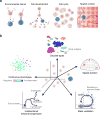Revealing the vectors of cellular identity with single-cell genomics
- PMID: 27824854
- PMCID: PMC5465644
- DOI: 10.1038/nbt.3711
Revealing the vectors of cellular identity with single-cell genomics
Abstract
Single-cell genomics has now made it possible to create a comprehensive atlas of human cells. At the same time, it has reopened definitions of a cell's identity and of the ways in which identity is regulated by the cell's molecular circuitry. Emerging computational analysis methods, especially in single-cell RNA sequencing (scRNA-seq), have already begun to reveal, in a data-driven way, the diverse simultaneous facets of a cell's identity, from discrete cell types to continuous dynamic transitions and spatial locations. These developments will eventually allow a cell to be represented as a superposition of 'basis vectors', each determining a different (but possibly dependent) aspect of cellular organization and function. However, computational methods must also overcome considerable challenges-from handling technical noise and data scale to forming new abstractions of biology. As the scale of single-cell experiments continues to increase, new computational approaches will be essential for constructing and characterizing a reference map of cell identities.
Conflict of interest statement
A.R. is a member of the Scientific Advisory Board for Thermo Fisher Scientific and Syros Pharmaceuticals and a consultant for Driver Group. A.W. and N.Y. declare no competing financial interests.
Figures



References
Publication types
MeSH terms
Substances
Grants and funding
LinkOut - more resources
Full Text Sources
Other Literature Sources
Medical
Research Materials

